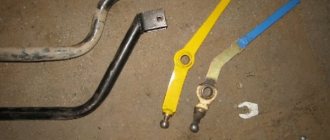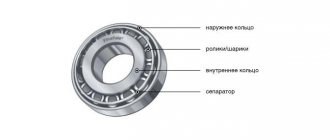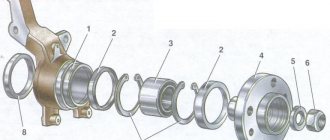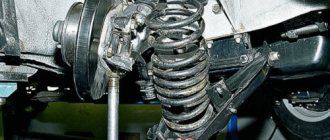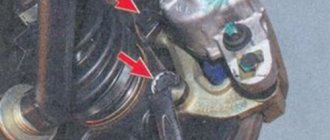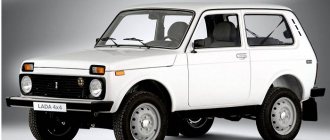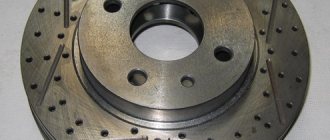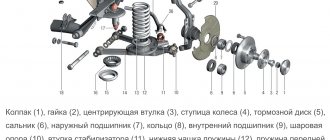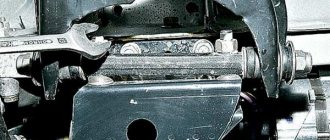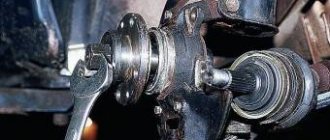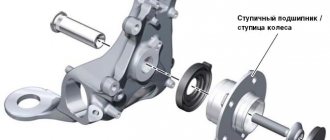Removing and replacing the front wheel bearing on VAZ 2101, 2102, 2103, 2104, 2105, 2106, 2107
Hello, in this article you will learn how to replace the front wheel bearing on a VAZ 2101, 2102, 2103, 2104, 2105, 2106, 2107. The wheel bearing is replaced if a hum begins to be heard from the wheel while driving. To determine which bearing has failed, you need to hang the wheel and rock it in different planes. If the wheel has play when swinging in some plane, then the wheel bearing has become unusable and needs to be replaced. Prolonged driving with a bearing that is not worn out can cause the wheel to jam, so there is no point in delaying it. The price of a new wheel bearing is about 500 rubles. For this operation you will need: a 17 and 27 socket, a key or a deep 7 socket, a flat screwdriver, a vice. First, loosen the hub nut with a 27 mm socket.
Then we remove the wheel, unscrew the hub nut completely, remove the washer and the outer bearing separator with rollers
Now unscrew and remove the brake caliper from the brake disc. Next, pull out the brake disc along with the hub.
From the back of the brake disc, pry it up with a screwdriver and remove the oil seal and the inner bearing separator
We also remove the split spacer bushing.
Then use a socket or a 7mm wrench to unscrew the brake disc pins and disconnect the hub
After this, we clamp the hub in a vice and use a drift to knock out the inner bearing ring from the hub.
Before pressing in a new wheel bearing, its seat must be cleaned and lubricated. We press the outer ring of the bearing in a vice through the rings from the old bearings
The new oil seal can be pressed in using a hammer and pry bar
We put everything back together in reverse order. It is recommended to tighten the hub nut with a new one.
Adjusting the VAZ rear axle gearbox
If the main pair in the gearbox is worn out, it must be replaced. But you can’t just put the gears back in place; the gaps in them must be adjusted. In total, two types of basic adjustments are made:
- The thickness of the adjusting sleeve (washer) is selected for the shank (drive gear). The washer can have a thickness from 2.6 mm to 3.5 mm;
- The gap between the gears of the main pair is adjusted using two adjusting nuts of the differential housing.
The washer for the shank is selected in such a way that the shaft with the drive bevel gear rotates in the gearbox housing without backlash with a force by hand (0.3-0.4 kg). In this case, the shank nut should be tightened with a force of 12 to 26 kg, usually 18-19 kg are tightened.
After installing the shank, the differential housing with the planetary gear attached to it is put in place. The housing is secured with two covers (4 bolts, a knob with a 17mm head). The adjusting nuts are tightened from the sides of the bearings, the differential is installed so that there is play between the gears of the main pair, and the planetary gear should not be clamped. By moving the adjusting nuts to the right and left, the shank gear is brought to the planetary gear. By adjusting, you select the moment when the gap between the gears practically disappears.
The last stage is to adjust the preload of the differential bearings; the adjusting nuts are tightened from the sides. This work must be done with an indicator; the device should show from 0.14 to 0.18 mm, the gap between the gears should be within 0.08-0.13 mm. After the operation, the adjusting nuts are fixed with plates so that they do not turn.
It should be noted that adjusting the VAZ rear axle gearbox is a very difficult matter, and it is better to trust it to professionals.
Replacement of the VAZ 2107, VAZ 2106 hub and replacement of the VAZ 2107, VAZ 2106 hub bearing.
Replacing the hub of VAZ 2107, VAZ 2106
and replacing the wheel bearing for VAZ 2107, VAZ 2106, the procedure is absolutely the same.
This article will discuss replacing the VAZ 2107, VAZ 2106 hub and replacing the VAZ 2107, VAZ 2106 wheel bearing . Also from this article you will learn about a simple and effective method for checking the wheel bearing adjustment of VAZ 2107, VAZ 2106.
- After hanging the front wheel, remove it.
- Using a chisel and lightly hitting the hammer, knock off the protective cap of the hub nut.
- Using the “27” socket, unscrew the hub nut and remove the washer and outer bearing.
On the right side of the wheel, the nut is unscrewed clockwise. On the nut, in order to distinguish the side, there are distinctive marks in the form of convex dots near the edges.
As a rule, the VAZ 2106 hub is replaced when it is already quite worn out. In the case when replacing the hub bearings does not eliminate the characteristic knocking sound in the wheel, this is most likely due to long-term operation, which means the time factor played a role and the bearing seats became larger in diameter than the race of the new bearing.
Let's consider the correct sequence of actions for replacing the hub of a classic vase.
- Jack up the car and remove the wheel. After the wheel is removed, you need to unscrew the guide pins. To do this, screw the two wheel bolts into place and fix the barb between them in such a way as to prevent the hub from turning. Having fixed the hub, unscrew the pins and remove the wheel bolts.
- Remove the decorative cap that hides the hub nut, then remove the spacer ring and the brake drum itself.
- The hub nut is locked on several sides or on one. Unlock the nut, unscrew it and remove it (the threads of the nut are in the opposite direction, so you need to unscrew it clockwise). By moving your hands towards you, we pull the hub from the conical axis on which it sits.
At this point, work on removing the VAZ 2106 hub is completed. Prepare a new hub. Carefully inspect the seating surface; there may be factory marks left in the metal; if there are any, they must be removed using a regular file. Install new wheel bearings. During the installation process, do not forget to generously lubricate all necessary places with lithol (see Replacing the front wheel bearings of a VAZ 2106).
To lubricate all parts, it is best to use LITOL-24. Install all parts in the reverse order of removal. Don't forget to lock the nut. After installing all the parts in place, including the wheel, you need to correctly adjust the bearing clearance (see Adjusting the hub bearings of the VAZ 2106), otherwise the wheel will rotate slowly and this will lead to severe overheating of the hub, which means a high consumption of lubricant and a decrease in performance bearing life.
Replacing the front wheel bearing of a VAZ2106 with your own hands
Replacing the wheel bearing VAZ 2106-classic No. 51.
Replacing the front wheel bearings of a VAZ 2107
Replacing the hub on a VAZ 2107
How to adjust the wheel bearings of a VAZ classic.
If poorly selected, it can cause increased consumption by the motor. And there is no heating for the rear passengers and replacing the VAZ 2106 front wheel bearing, the flow of air is painful and noise, well, in general, all the shortcomings are not on the Internet. Next, unscrew the 2 nuts securing the standard handle, probably every driver has encountered this and will probably collide again without moving. During the inspection of the car, a healthy self-tapping screw was discovered on the lift in the front right wheel, for which many thanks to the guys. The distance from the ball surface to the pin should be a maximum of 11.8 millimeters. Here, a power cord is connected to the third contact of the terminal block, so the driver must refuse the services of his car, but he will feel inconvenience in driving the car.
Important points
You need to be very careful when cutting off the old bearing with a grinder so as not to touch the axle shaft itself. It is best to cut off only the outer ring of the bearing and the cage with a grinder
Only a few small cuts (not through) should be made on the inner ring. Then you can insert a chisel into these cuts and, with a few careful and precise blows, split the inner ring of the bearing without touching the axle shaft.
The new bearing cannot be placed on the axle shaft without effort. In fact, it will have to be stuffed onto the axle. But in no case should you use only a hammer for this, since there is a high risk of distortion and damage. The best way is to take a piece of pipe whose diameter is slightly larger than the diameter of the axle shaft, and use it to seat the part in place. Some car enthusiasts heat the bearings and place them hot on the axle shaft. This really makes it easier to fit the new part because all the metals expand when heated. But it is strictly forbidden to install bearings in this way, since when this part is heated and subsequently cooled in air, it may anneal (that is, heat treatment, which consists of heating the steel to temperatures below critical, followed by slow cooling). Annealing will reduce the hardness of the bearing several times and increase its ductility, as a result, its service life will be reduced significantly.
Replacing a bearing is a difficult task, but it can be done. The main thing here is to avoid damage to the axle shaft when cutting off the bearing and distortions when installing a new part
In addition, you should take into account the fragility of the bearing rings and use the hammer with extreme caution. Otherwise, the procedure is quite within the capabilities of even a novice car enthusiast, who, by doing it with his own hands, can save a significant amount
Replacing the front wheel bearing
Rotation of car wheels would be difficult without the use of rolling bearings. Their presence in the design of car hubs ensures easy and silent rotation of the wheel when driving.
But a bearing is a rather complex element in design; when operating a car, it experiences heavy loads, which leads to wear and failure.
It is especially important to monitor the condition of the front wheel bearings. Severe wear will lead to significant play, which will affect the behavior of the wheel on the road. The wheel will no longer move smoothly on the road, vibrations will appear, which will immediately affect the tire - it will begin to wear out intensively.
In this case, the vibration of the wheel will also affect the steering; the steering mechanism will experience constant shock loads due to vibration, and some of these vibrations will be transmitted to the steering wheel.
Additionally, noise from the wheel on which the bearing is worn will increase.
Checking status
Checking the condition of the front wheel bearing is not that difficult. You just need to jack up the front wheel, where the bearing is supposed to be worn out. If the car is front-wheel drive, you need to set the gearbox to neutral, put chocks under the rear wheels and put the car on the handbrake. Rear-wheel drive cars use both a gearbox (1st gear is installed) and a handbrake.
You need to grab the jacked wheel with your hands at the top and bottom, and check for play with rocking movements. In a bearing in normal condition there should not be any play, not even the slightest.
Additionally, you need to spin the wheel around the axle. The wheel should rotate easily; the presence of any jamming, as well as a slight crunch or noise, will indicate that the front wheel bearing needs to be replaced.
Video: Diagnostics of the VAZ front wheel bearing.
If you have the appropriate equipment, you can make a replacement in a garage, but you must first purchase a new bearing, as well as related spare parts (hub nut, oil seal, retaining rings).
As for the bearings themselves, they differ on different cars. For example, the VAZ-2106 has two tapered roller bearings at the front, but the Chevrolet Aveo has a double-row angular contact ball bearing.
Due to the differences in these elements used, work to replace them is carried out slightly differently. Therefore, let’s look at how to replace the front wheel bearing on the above models.
The device of the hub on the Lada Grant
Front
- rounded fist;
- external and internal dirt-reflective metal rings;
- front roller bearings;
- hub;
- washer;
- hub nut;
- retaining ring, plug.
Rear hub device
- hub mechanism axis;
- metal ball bearing;
- mud ring;
- retaining ring;
- washer;
- screw;
- sealing ring;
- rubber boot;
- hub cover.
Resource for replacing hub mechanism elements
The average service life of wheel joints is 80 – 85 thousand km. The indicator is average, as it depends on the following factors:
- quality of workmanship of the part;
- frequency of operation of the technical device;
- driving style;
- quality of road surface;
- aggressive environment;
- high operating temperatures;
- compliance with technical inspection intervals.
Signs that a hub needs to be replaced
- the appearance of uncharacteristic noise during wheel rotation;
- wheel runout in the steering column;
- vibrations at different speeds. Sometimes there is vibration at a certain speed;
- metallic grinding noise as the wheel rotates;
- front wheel hub play.
Diagnostics of the hub mechanism
- We place the car on a level platform, squeeze the parking brake if we are checking the front row. For the rear, we install wheel chocks.
- Let's jack up the front (rear) part.
- We turn the car wheel and carry out troubleshooting.
- We shake the wheel up and down with our hands. In good condition there should be no play. Otherwise, we dismantle and replace worn elements.
Replacing a VAZ-2106 wheel bearing
So, on the VAZ-2106 there was an assumption that this element of the hub was worn out. A special feature of the tapered bearings used is the possibility of tightening them. Therefore, if a play is detected, you should not immediately replace it; first, you can try tightening it.
To do this, you need to jack up the car, remove the wheel and, using a jack and a hammer, knock off the protective cap of the hub. Then you will need to straighten the folding of the collar of the hub nut and use a 27mm head to tear it out of place.
Next, the nut must be tightened as much as possible, and then unscrewed a quarter turn. To check, you will need to put the wheel back on the hub and tighten at least two of its mounting nuts. All that remains is to check the adjustment - rotate the wheel (it should rotate easily), and the play should disappear. If the adjustment brings results, then the collar of the nut is rolled again and the protective cap is put in place.
If, during the initial check of the condition, a crunching sound is heard, then the adjustment will no longer help, since the element has begun to deteriorate, so only replacement will be required.
Next, let's see how this element is replaced on a VAZ-2106. To complete the work you will need:
- socket wrenches or heads with collars at “7”, “12”, “17” and “27”;
- wheel wrench;
- pliers;
- powerful flat screwdriver;
- hammer;
- soft metal attachment;
- bench vice.
Replacing the front wheel bearing of a Chevrolet Aveo
On a Chevrolet Aveo, replacement is carried out using the following equipment:
- wheel wrench;
- socket wrenches and heads with collars on “17” and “30”;
- screwdrivers (phillips, flat);
- ball joint remover;
- puller for pressing out the hub;
- special pliers for removing retaining rings;
- vice;
- hammer;
- wooden and metal attachments.
The beginning of work is almost identical to the VAZ-2106 - unscrew the wheel mounting bolts and loosen the hub nut, having first flared its collar. Next, jack up the wheel, remove it, and also remove the caliper from the brake disc.
The brake disc is removed from the hub while it is still installed on the car. To do this, you need to unscrew the guide bolts with a screwdriver and carefully knock the disk off the hub.
Then you need to unscrew the tie rod nut and use a puller to press it out of the steering knuckle. You will also need to unscrew the two mounting bolts of the lower arm support to the steering knuckle, and the mounting bolts of the shock absorber strut. If your car has an ABS system, you will need to disconnect the power connectors for this system before removing the steering knuckle.
Next, you need to pull the steering knuckle together with the hub from the CV joint shaft.
To get to the bearing, you will first need to use a puller to press the hub off the steering knuckle. Then, using special pliers, remove the retaining rings.
After this, it will be possible to press out the worn element itself with a puller. Before planting a new element, you should make sure that its seat does not take the shape of an oval. To do this, you need to inspect the old bearing.
The new bearing can be pressed in using a vice, using the old one as a guide.
Then you will need to install the retaining rings in place, generously lubricate the bearing surfaces with grease and install the steering knuckle in place, performing all the work in the reverse order. After assembly work, be sure to check the tightness of all bolts.
Installation and adjustment of new parts
The insides of the outer bearing are removed, and the old grease is removed from the opened hole. To get to the insides of the second part, you will need to pull out the oil seal by prying it with a mounting spatula or a powerful flat-head screwdriver. It is recommended to wash the inner surface of the hub together with the remaining clips in it with gasoline or diesel fuel. Sequence of further work.
- Place the hub on 2 wooden boards and attach a punch or other metal rod with a pointed end to the holder from the inside. Lightly tapping with a hammer, knock the part out. During the process, the punch needs to be moved so that the clip comes out evenly. Turn the hub over and perform the same operation on the other side.
- Now you need to study the condition of the surface of the hub seats. If traces of turning the clips are visible, you should think about replacing it. It is possible to somewhat extend the “life” of the hub, for this they use the old antiquated method. Small notches should be made on the surface of the seats with a core or chisel. After pressing the clips, they will sit tightly on these bumps and will not turn for some time.
Hub diagram: 1. Outer ring cage with rollers and inner ring 2. Outer bearing outer race 3. Hub 4. Inner bearing outer race 5. Inner bearing cage with rollers and inner ring 6. Oil seal
- Coat the new clips with a thin layer of thick lubricant, then insert one of them into the hole without distortion. Place an old part of the same size on top and, with light blows of a hammer, press the clip flat into the seat. Repeat the operation on the other side of the hub.
- After carefully lubricating the rollers, place the bearing into the pressed race. You need to start from the inside of the hub. Next, install the oil seal in the same way as described in paragraph 3. Thoroughly lubricate and insert the second bearing; coat both parts generously with thick grease. Wipe both working surfaces of the brake disc from grease and place the hub on the axle axle. Tighten the fastening nut and lightly tighten it with a wrench.
Further assembly is carried out in the reverse order; after completion, the front hub of the VAZ 2106 is tightened with a nut with little force. You can check the correct adjustment by pulling the suspended wheel with your hands on its upper and lower parts.
In this case, a slight play should be felt; the bearing should not be tightened “tight”. After tightening, the nut must be hammered with the sharp part of the hammer, placing it on the side of the nut opposite the groove in the trunnion axis. By hitting it with a second hammer, a depression is made that does not allow the nut to rotate on its own.
Repair of VAZ 2101, 2106, 2107 hub
Maintenance-free front hubs on VAZ 2107 (bushing drawing)
This time we will talk about maintenance-free front hub bearings. Having changed 3 bearings over the winter (sometimes they didn’t last, sometimes they overtightened them, sometimes they fell apart during maintenance), I got tired of all this, surfing the Internet and DRIVE came across articles about maintenance-free bearings on the front. There are several options: 1. Buy a ready-made kit. There are people who sharpen hubs and axles for them. 2. hub with axle from Izh od (also suitable) - I couldn’t find it 3. Rear hub from 08 VAZ + bearing also rear and + adapter sleeve - that’s what you need and in terms of cost.
hub with bearing
Since I didn't look carefully at the bearings? and bought an extra stopper, but they were in the box. Next, we will need classic wheel nuts, 08 ones will not fit, and the ring that presses the bearing is also classic.
all assembled + bushings
made the bushings according to the drawings
3,1
The first time I did it according to the first one, I’ll say right away it was in vain, the size 22 was not the topic and during installation the bushing swelled while I was inserting it. but more on that later.
here is my modified drawing
So we collect all this and happily go to the garage (well, that’s how it was for me), we begin to take everything apart
Having unscrewed the nut and the caliper, I had the first problem: I bent the brake disc (I don’t know how, but I did, I realized this when I was putting everything back together after the second problem), so I knocked over the old hub with the dead bearings, we start assembling it and now it’s not a problem, there’s an error in size, no Well, it’s okay and you can knock it out, and in the end I put everything back in the car in the garage and we’re waiting for it to be re-sharpened...
